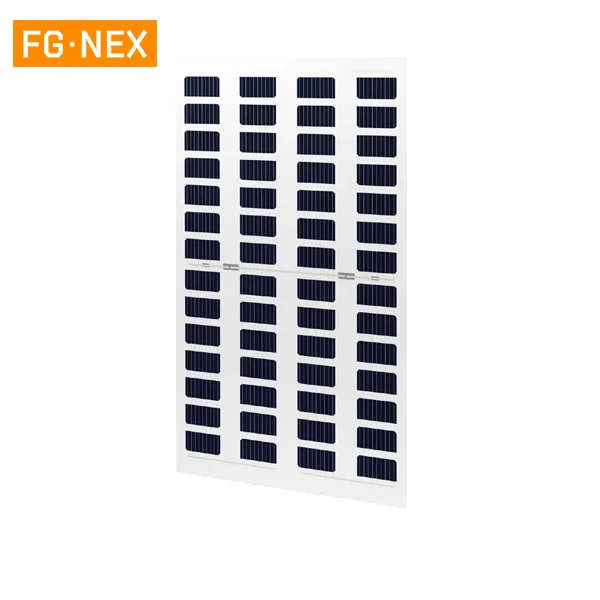- This topic is empty.
-
AuthorPosts
-
2025-02-24 at 1:58 pm #83654
With the increasing global demand for renewable energy, solar photovoltaic technology is also developing. Bifacial Solar Panels have been widely used in recent years due to their advantage of utilizing both front and reverse light to generate electricity. However, in areas with high wind power, such as coastal areas, plateaus, deserts, etc., the wind resistance of solar panels has become a key issue. This article will explore in-depth wind resistance of double-sided solar panels and how to optimize their design and installation to improve wind resistance.
1. Analysis of wind resistance of double-sided solar panels
1.1 The influence of structural characteristics on wind resistance
The structure of double-sided solar panels is different from that of traditional single-sided solar panels. The design not only considers frontal lighting but also optimizes the utilization of reflected light in the back. Therefore, it usually adopts a higher bracket mounting method to reduce ground occlusion, thereby improving the efficiency of backlight utilization. The direct impact of this design is the increase in wind-receiving area, which may affect wind resistance.
However, double-sided solar panels also have their advantages in wind resistance:
Weight distribution balance: Due to the double-sided design, the panels are usually packaged in double-glass, making the overall weight more balanced than traditional single-glass components, reducing the possibility of being blown over by the wind.
Rigidity enhancement: The double-glass packaging increases the structural strength of the panel, and improves the resistance to bending and impact, making it more stable in strong wind environments.
Optimized installation method: Some double-sided solar systems use stronger brackets or tracking systems to better withstand wind effects.
1.2 The impact of wind load on double-sided solar panels
Wind Load refers to the pressure applied by wind to solar panels, which mainly depends on the wind speed, component inclination, installation height, and fixing method.
Wind speed: The greater the wind speed, the greater the pressure on the solar panels. Especially in areas with frequent typhoons and hurricanes, high wind speed may cause the panels to bend, shift or even damage.
Component inclination: Components with larger inclination angles suffer less wind resistance, while components installed vertically have greater wind resistance and weaker wind resistance.
Installation height: The higher the ground, the greater the wind speed, so the double-sided components need to take into account both the height and wind resistance requirements when installing.
Fixing method: Different fixing methods will affect wind resistance, such as ground brackets, electric tracking systems, roof fixing, etc., and the wind resistance of different installation methods is different.
According to international wind load standards (such as ASCE 7-16), solar modules usually need to withstand wind speeds of 140-160 kilometers per hour (about 87-100 miles) and some specially designed systems can even withstand strong winds of 200 kilometers per hour.

2. How to improve the wind resistance of double-sided solar panels?
2.1 Choose a reasonable installation method
Different installation methods have a great impact on wind resistance. The following are several common installation methods and their wind resistance analysis:
Ground installation (fixed): Suitable for areas with high wind force, the foundation is stable and the bracket can optimize the angle and reduce wind resistance, and have strong wind resistance.
Ground installation (tracking): Single-axis or double-axis tracking systems can improve power generation efficiency, but due to their dynamic adjustment characteristics, the wind resistance is slightly weaker than that of fixed ones, and an additional wind speed sensing system is required to automatically adjust the angle and reduce wind resistance.
Roof installation: Roof installation requires consideration of building structure load-bearing capacity and a reinforced bracket system is used to ensure that it does not loosen under strong winds.
Floating solar system: applied to water surfaces, such as lakes, reservoirs, etc. This type of installation method is challenging in wind resistance and requires special design to prevent strong winds from overturning the components.
2.2 Using high-strength bracket material
Brackets are a key component of solar panels' wind resistance. High-strength aluminum alloy or galvanized steel brackets are more corrosion-resistant than ordinary metal brackets and provide higher structural strength. Scientific stent design (such as strengthening the pillars and increasing the connection points) can effectively reduce the impact of wind on the components.
2.3 Appropriately reduce the inclination angle of the component
Appropriate adjustment of the tilt angle of the assembly can reduce wind resistance. Normally:
The components with an inclination angle of 0°-20° are least affected by the wind and are suitable for areas with strong wind.
The inclination angle of 30°-45° is suitable for places with better lighting conditions, but the wind load may increase.
Installation methods greater than 45° have greater wind resistance and require additional reinforcement.
2.4 Battery board with wind-resistant design
At present, some high-end double-sided solar panels on the market have been designed to consider wind resistance, such as:
Double glass packaging design improves component rigidity and reduces deformation caused by wind pressure.
The frame is optimized and the aerodynamic design is used to reduce wind resistance.
An intelligent wind speed sensing system can automatically adjust the component angle during strong winds to reduce wind pressure.
2.5 Added windshield facilities
In areas with extremely strong winds, wind barriers or vegetation barriers can be added around the photovoltaic array to reduce the direct impact of wind speed on the components. This method is especially suitable for deserts, coastal areas, and other areas.
The wind resistance of double-sided solar panels depends on a variety of factors, including component structure, installation method, inclination angle, support material, etc. Reasonable design and installation can greatly improve its wind resistance and enable it to operate stably in high wind speed environments. For areas with high wind power, it is recommended to use low inclination installation, reinforced brackets, double glass packaging, and wind speed sensing systems to ensure the safety and long-term stability of solar power plants. Under the trend of global new energy development, double-sided solar panels not only improve power generation efficiency but also continuously optimize wind resistance design to ensure stable operation in various extreme environments and provide more reliable development of renewable energy guarantee.
http://www.fgnexsolar.com
Wuxi Fgnex Technology Co., Ltd. -
AuthorPosts
- You must be logged in to reply to this topic.


